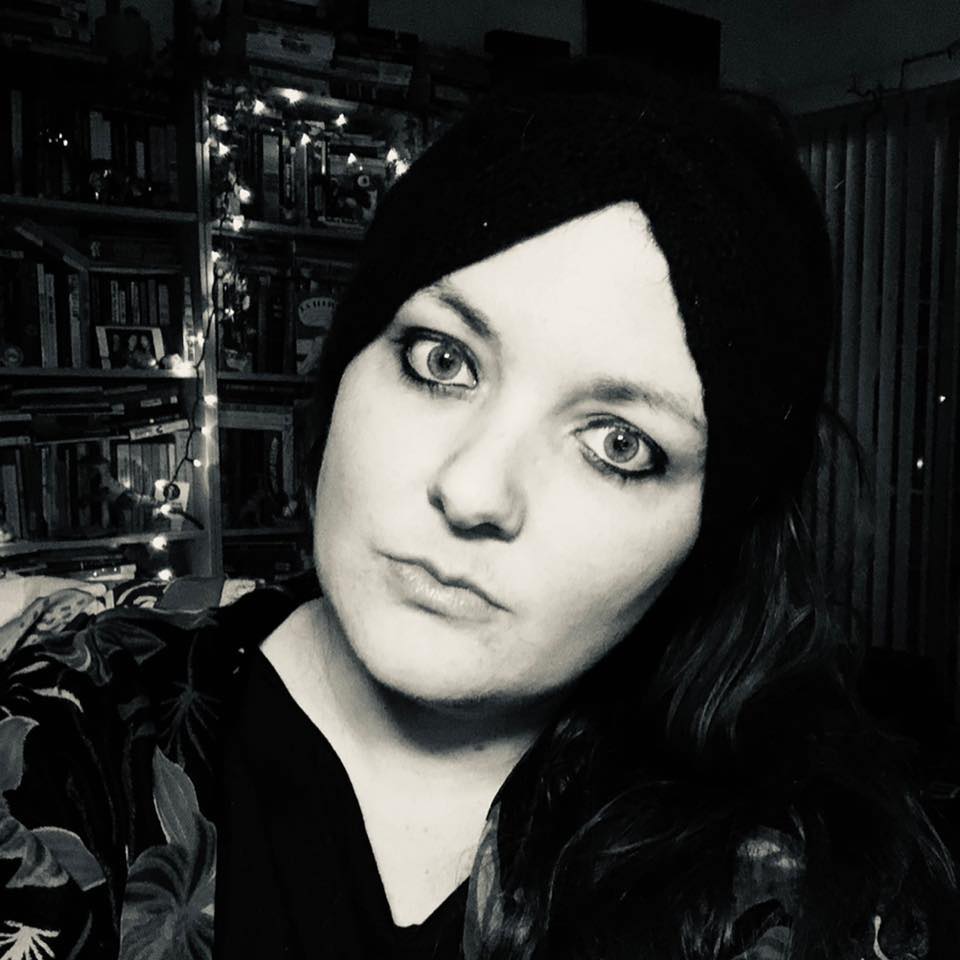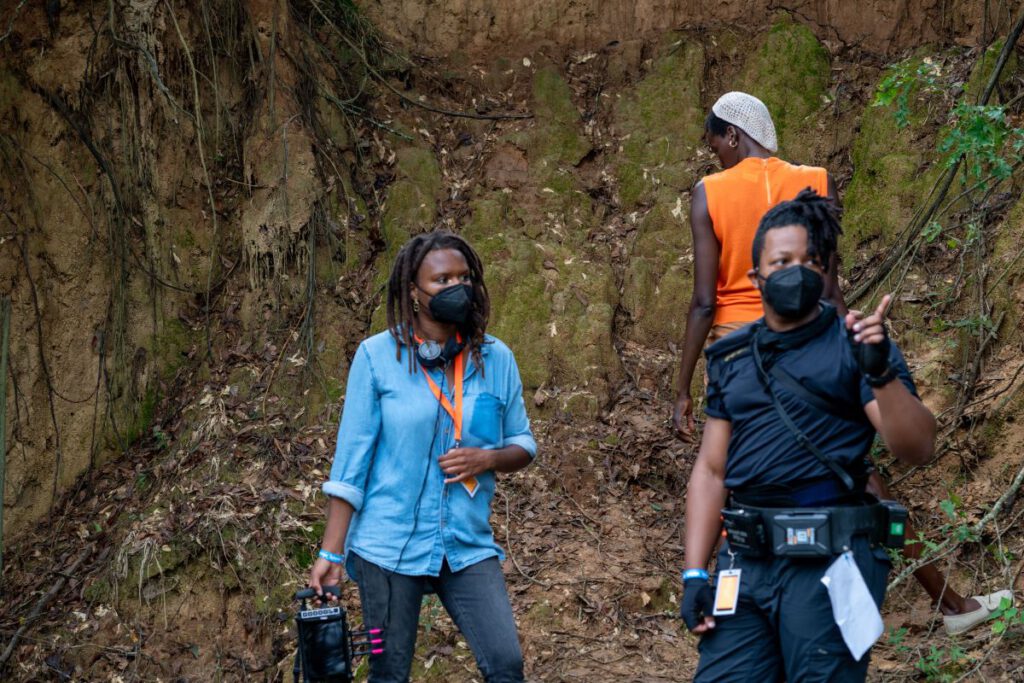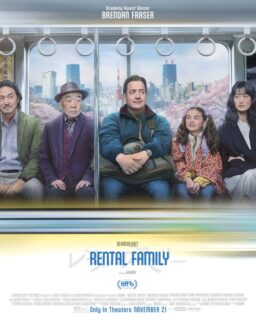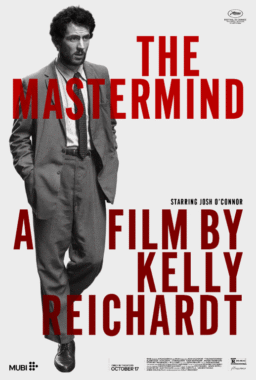Raven Jackson’s lyrical feature debut, “All Dirt Roads Taste of Salt,” which had its world premiere at the Sundance Film Festival in January and has played many festivals since, follows the life of Mack (played at different ages by Charleen McClure, Kaylee Nicole Johnson, and Zainab Jah) as she grows up in rural Mississippi. The kaleidoscopic film, shot in stunning 35mm, flashes backward and forwards through emotionally resonant moments in her life, sharing glimpses of her relationships with her sister, her parents, her grandmother, her first love, and the natural world around her. Alive with textures and sounds and deeply felt emotions, this evocative film announces Jackson as a bold new cinematic voice.
A poet, photographer, and filmmaker originally from Tennessee, Jackson holds MFAs from New York University’s Graduate Film Program and the New School’s Writing Program. Her work explores the terrain of emotional interiority, how people can be shaped by moments that don’t register immediately, and the body’s complex relationship with nature.
RogerEbert.com spoke to Jackson at the Chicago International Film Festival about her poetic feature film, trusting the creative process, being open to discoveries on set, the emotional impact of seemingly “small” moments, and finding inspiration in the work of Lynne Ramsay.
I’ve seen your short film “Nettles” probably ten times. It’s one of my favorite short films ever. It taps into those emotional, stinging moments that stick with you, but you don’t know why they’re sticking with you. And I feel like you feel that in “All Dirt Roads Taste of Salt” as well. I’d love to hear sort of where the concept of “Nettles” came from and then how it finds itself in “All Dirt Roads Taste of Salt.”
I knew coming into “Nettles” that I wanted to explore moments, as you mentioned, that stay with you, even if you don’t know why, once you look back on them. I have ones like that in my own life, where it felt like a small moment, but it felt like there was a beginning and an end, like a shift that happened after the moment. I was interested in moments that felt like a shift, even if it was a subtle one. Of course, there are varying degrees in the film of what those moments are in terms of the loudness of them. But I was interested in looking for the seemingly small ones, where there’s a shift that happens. So I knew after “Nettles” that I was interested in playing with form in a longer project, but also allowing myself to explore those seemingly small moments, more mundane moments, and going further with that in a feature-length film while also having more profound moments, like the loss of a family member, while not losing the quieter moments. As a person, I am drawn to those moments. So, I wanted to allow room for that in the feature.
There are definitely some moments in “Nettles” that I feel are reflected in “All Dirt Roads Taste of Salt,” like the last sequence of the short where the woman is going into the water, and you kind of feel that moment towards the end of “All Dirt Roads Taste of Salt.”
Right. The script changed going into production, but there would have been even a closer rhyme. Like, there’s one scene that would have really rhymed with that one.
Obviously, you are a poet, and the film has these moments where they call back to each other but shift a little. For example, one sister is teaching the other how to kiss, and then the next scene is the mom teaching her how to put lipstick on. They’re similar moments about lips, but they’re not quite the same. It feels almost like a couplet.
Yeah, I love that. A couplet. Completely. It’s looking for the slant rhymes. That’s what I like to say. Moments and how they speak to each other. And that is intentional. And actually, not every rhyme was scripted. Some were found, but that was in the script and actually right after each other.

I love hearing you say some moments were found. I know some directors know exactly what they want. They have it scripted, and they write it out. Some directors like to search and find it as they’re filming. Do you feel one way or the other about your filmmaking?
I know what I’m looking for, but I’m open to how I get there. And I really do feel the script is a starting point for me. I know what I’m looking for, but the day of, I’m very present, and if something isn’t working, I think I’m good at being very like, “Oh, something feels off here,” and trying to figure it out by going through what it could be, whether it’s blocking, costuming, etc. You know what I mean? Like, what is not working? So I think though I know what I’m looking for, I tried to be loose on set so I can be open to something better. A surprise. There were a lot of pivots we had to do on the film. One of them became our first key image! It’s just like being open to the potential. I really tried to do that.
And this is such a collaborative film. You have these performers who, for the most part, don’t have much dialogue. It’s a lot of externalization of internal feelings. How did you go about casting to get performers who could work with you that way?
It was a journey for sure, finding the people and a lot of trusting the process. All of the people cast are so brilliant. For instance, with Reginald Helms Jr., who plays the older Wood, he’s a musician. He’s a rapper, and it was me just Googling in the production office one night. Wood hadn’t landed yet, and I think I Googled musicians from the South, and one of his music videos came up. I was inspired by how he’s so expressive with his body but also his eyes. He has such great eyes. It just happened that someone on our production team knew someone on his management team. So, from there, we got a conversation going. Then Charleen McClure, who plays Mack, is a poet; she’s someone I know in my life. And I just saw it one day, and I wanted to explore with her. I needed someone whose face carries many years. She has that. Whose face can express a lot without saying much. She has that. I think that’s what I looked for a lot. Faces and bodies that you say a lot without needing to rely on words. Everyone cast can do that. That was really just across the board. I needed that for all the characters. And with Sheila Atim, we had a conversation, and I found out she was aware of clay dirt. I was like, “Oh, it’s you.” And Chris Chalk is amazing. So that was key, being able to express and be expressive without words, like through your face and your body. But also just following what moved me. Like when someone would say something, or I would have a conversation, and I would see something, and I’d be moved. Just trusting that and following it.

Something that I really loved about the film is just how tactile and textural it is. Like the scene during the funeral when they’re in their grandma’s car. I felt like I was in their car. I felt like I could smell that car. How did you capture those textures?
At every level, I was looking for the right elements. I remember even when Miss Jamie, Miss Jamie Lee Hampton, who plays Grandma Betty.
She’s so good.
She’s so good! Speaking of casting, that was an open casting call in Memphis. She was there with her daughter and her grandchildren, just sitting to the side. I saw her, and I had already cast Charlene at that point, so when I saw her, I thought there was a similarity to Charlene here. But then she also had a gold tooth where my mom had hers when she had one. And it was important for me to cast someone who knew about clay dirt for that role. And she did. And we had a great conversation. And so she was amazing. But I remember, even in the casting process for her, like, I remember seeing photographs of her hands. She has great hands, the texture of her hands. So, the texture of the car we found was great, but also the sound for me was important. It’s a quieter environmental sound, but also the sound just like the seats moving. So it was about all of those layers, and trying to be intentional with those layers to get at that tactility.
You mentioned hands, and I’m sure you’ve been asked a lot about hands, but what I was particularly interested in is the hands are so emotional in this film. Every time you cut to a hand, there’s a lot pulsing through it. I was wondering how you direct an actor’s hands?
You know, I try not to when possible … I mean, there’s one scene, the baby washing scene, when they might have been aware it was mostly their hands. But I try not to call attention to it because I wanted it to feel natural. Because with natural instances, it’s your whole body, not just your hands, so I wanted those moments to feel like a whole. Even in the scene with Mac and Wood at the grocery store–
That was the scene I was thinking of.
Even that, when we shot just hands, they might have known. I don’t know if I told them or if I just told production. But either way, it’s like I’m trying to be, again, to be intentional with it being a full-body experience, even if I’m getting details of it. Because for me, that translates. I want it to feel emotionally, the full body, not just the hand, but all of it.

You mentioned clay dirt a couple of times. Obviously, that’s a huge metaphor in the film. And that opening sequence where she’s sort of playing with the silt, that also really made me, speaking of moments that you forget about until you’re thinking about it, but as a kid, I always used to play with the silt. That was one of my favorite things to do. And the way she’s playing with it really brought me back to being like six, like after the rain. I just love to hear your thoughts on silt because silt is so interesting. It’s almost liquid, but you know, it’s dirt, and you know that it can be harder. And I always think as a kid, I was always like, how does it do that? I did not understand the elements. I still don’t really understand it. I don’t know how dirt can be, like the pyramids and silt at the same time.
I think about my own childhood, too, and just the curiosity and the wanting to be curious about the water, the dirt, the silt, and wanting to give room to that curiosity and how that could speak to these characters’ closeness to nature. And so, in that moment, I wasn’t thinking, you know, at least not at the top of my mind, Ooh this is … I think the dirt means this, silt means this in this moment, but I was thinking about these characters’ closeness to nature, and it felt honest that she would spend time looking at it. It’s funny because there are some discoveries, too. You can’t plan for things. I knew how to get a water shot. I remember after she did that, I saw the water, that dirt clearly drifting in the water, and it was like, Ooh, this feels so true to the whole film. In transition. It really landed when I saw it. That’s what that moment did for me. We shot that earlier on in the process, too.
I wanted to ask about your work with cinematographer Jomo Fray. Particularly, there’s the scene during the party, and it’s sort of from Mack’s perspective, almost like she’s looking up at her parents. I loved the way that you were in her perspective in that scene. I’d love to hear how you worked with Fray on the perspectives in the film.
With that scene in particular, I think something that’s really beautiful about the way Jomo, and I like to work is that we infuse our work with a lot of play, which I think adds to being loose and available and present to what’s happening when you’re actually on set. So, the day before we shot that scene, I asked him, what lens have we not used? So ended up being a very long lens, I want to say the 150. It’s not a lens that we would naturally turn to shoot that scene. But I think it was a challenge that we both liked. And also, it’s like, if it’s not good, we’ll change it, you know, I mean? It ended up working out so beautifully.
There are certain scenes where I want drifting. It’s gonna be a longer shot, and I want drifting. That’s the case for the dance scene. And I told Jomo to follow what moves you, and if I want to do something else, I’ll tell you. He did his beautiful work of following the hands connecting between Isaiah and Evelyn, you know, just that moment. We’d blocked it, but it’s also trusting in those longer shots the following, the drifting. So that was our dance, because we were dancing, doing our own dance in that scene, too, and Jomo was dancing with the actress as well, and so that was a dance of that scene.
It’s a beautiful scene, and again, it’s so tactile. The wood paneling. I felt like I could feel the wood. I felt like I could smell that room. I also grew up not in the South, but I grew up in the country, so I feel like any time I see a movie that captures rural life well, I’m always very impressed. You know, the person probably grew up also in a rural place.
I was like, “My family’s not gonna let me do this wrong.” It was really important for me to be intentional about being specific. Making it feel authentic. And there’ll be moments where I remember I actually sent my parents a photograph of that room. And I looked at my grandma’s photo albums. I have touchpoints. It was important for me to really get it right.
Did you always know exactly how you wanted to edit it? Or did you sort of feel it after you had the raw footage? There’s this emotional throughline, but the film is also so kaleidoscopic.
It’s so modular. I knew the script wouldn’t be the final film. I knew that going into production, going into the edit. So it was really having to see, okay, what is here to work with, and then, in the same way, that with the script, it was a lot of writing and then taking away and trusting the process of that, it was a lot of exploring and then trying things in different places. We shot more than is in the final film. A lot of beautiful things worked in the script, but the final film didn’t need it or want it. Listening to that and trusting the process of the exploration, taking days off, and then coming back to it. So it was a lot of that. Knowing the emotional journey that I’m aiming to build and then really being intentional about how it’s building. What does it need here? Do I need to split up this portrait I thought was actually going to be in one chunk? Does it actually want to be split into three moments that are placed at different points in the film? Things like that. A lot of questions like that to build that emotional journey.
Are there any women filmmakers who have either inspired you or that you think not enough people have seen?
What comes to mind is a short film, Lynne Ramsay’s “Small Deaths.” And I’m just thinking about the permission that the film gave me when I watched it to explore form. I really did say, “Ooh, I can do that?” You know what I mean? So I want to highlight that film because I think if there’s any folks who are interested in playing with form, who are thinking about maybe the potentials of filmmaking they haven’t thought about yet. I think that’s a film for me that really opened my world to what’s possible.
“All Dirt Roads Taste of Salt” will be available in theaters on November 3rd.












